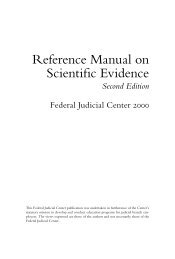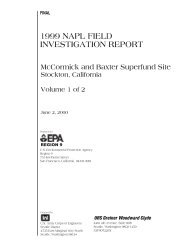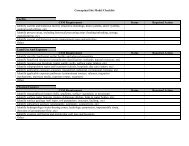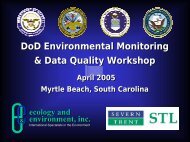Source Zone Delineation Demonstration Report - Triad Resource ...
Source Zone Delineation Demonstration Report - Triad Resource ...
Source Zone Delineation Demonstration Report - Triad Resource ...
Create successful ePaper yourself
Turn your PDF publications into a flip-book with our unique Google optimized e-Paper software.
EXECUTIVE SUMMARYThis report documents the results of the Hill Air Force Base Operable Unit 12 (OU 12) <strong>Source</strong> <strong>Zone</strong><strong>Delineation</strong> <strong>Demonstration</strong>. The demonstration was conducted to investigate volatile organic compoundcontamination in the vadose zone of the suspected OU 12 source area using rapid decision-making basedon real-time data collected in the field via direct sampling ion trap mass spectrometry (DSITMS) for rapididentification of contaminant concentrations. The investigation consisted of two technologydemonstrations – (1) wireline cone penetrometer system for multiple tool usage and (2) soil vaporextraction (SVE) for vadose zone characterization.The Wireline CPT demonstration was conducted within the vadose zone and capillary fringe underlyingthe general area defined as the suspected source zone at OU 12. During the first four days of soilsampling using the Wireline CPT sampler, approximately 205 soil samples were collected from verticaltraces at 5 discrete locations (approximately 50 samples per day). An increase in sample collectionfrequency occurred during the last five days of field operations, where approximately 395 soil sampleswere collected from vertical traces at 11 discrete locations (approximately 80 samples per day). In total,599 soil samples were collected from vertical traces at 16 discrete locations during the nine working daysof the Wireline CPT demonstration. Samples were generally collected along 1-foot sampling intervalsfrom approximately 20 to 65 feet bgs.Inference of the magnitude and spatial extent of TCE contamination in the vadose zone at OU 12 wasaccomplished using three-dimensional modeling of TCE concentration measured in the soil samplesretrieved with the Wireline CPT sampler. An isometric view of the 100 g/kg iso-concentration surfacefrom the final three-dimensional model of TCE contamination in soil is shown in Figure ES-1. The viewis from the southwest corner of the model domain, looking to the northeast. The spheres on each of theborings represent soil sample locations, color-coded according to the measured concentration of TCE.The highest concentrations of TCE were observed in samples collected from U2-1804 at a depth of 27feet (154,000 g/kg) and 29 feet (73,000 g/kg) below ground surface (bgs); from U2-1807 at 33 feet bgs(144,000 g/kg); and from U2-1817 at 29 feet bgs (131,900 g/kg). In contrast, surrounding boringsyielded no soil samples with a measured TCE concentration greater than 10,000 g/kg. During theanalysis of samples collected from U12-1807, four samples (30 to 33 feet bgs) were observed to contain alight nonaqueous phase liquid (LNAPL). In addition, two samples (27 to 29 feet bgs) from U12-1804were observed to contain a LNAPL.Based on the results of the TCE soil model, contamination in the vadose zone at OU 12 has a distinctlylayered character. Individual layers are elliptical in plan-view, approximately 5 to 10 feet thick, severalhundreds of square feet in areal extent, and are present over most of the entire thickness of the vadosezone within the modeled region. The layers of TCE contamination tend to reside in silty-sand soils,joined vertically by narrow and tortuous throat-like connections evocative of migration pathways. Thisspatial pattern of TCE contamination in soil suggests that water, percolating downward under the force ofgravity and carrying with it dissolved TCE, spreads laterally when it encounters capillary barriers.Pathways through the barriers are ultimately found, providing the contaminated water with a new avenuefor downward percolation.March 2003 ES-1 OU 12 <strong>Demonstration</strong> <strong>Report</strong>Final










